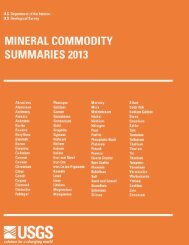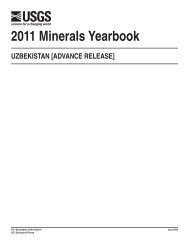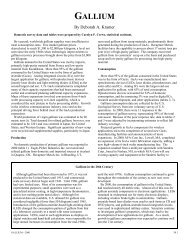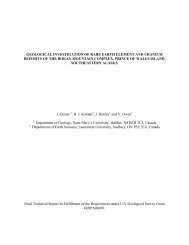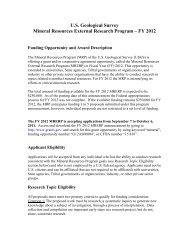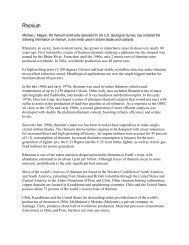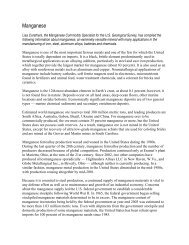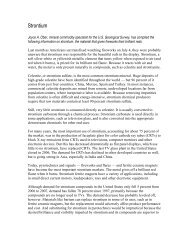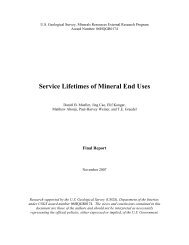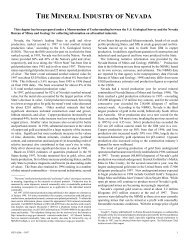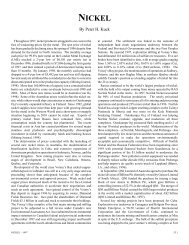Mineral Commodity Summaries 2003 - Mineral Resources Program ...
Mineral Commodity Summaries 2003 - Mineral Resources Program ...
Mineral Commodity Summaries 2003 - Mineral Resources Program ...
You also want an ePaper? Increase the reach of your titles
YUMPU automatically turns print PDFs into web optimized ePapers that Google loves.
82<br />
INDIUM 1<br />
(Data in metric tons, unless otherwise noted)<br />
Domestic Production and Use: Indium was not recovered from ores in the United States in 2002. Domestically<br />
produced standard grade indium was derived by upgrading lower grade imported indium metal. Two companies, one<br />
each in New York and Rhode Island, were the major producers of indium metal and indium products in 2002. Several<br />
additional firms produced high-purity indium shapes, alloys, and compounds from imported indium. Thin-film coatings,<br />
which are used in applications such as liquid crystal displays (LCDs) and electroluminescent lamps, continued to be<br />
the largest end use. Indium semiconductor compounds were used in infrared detectors, high-speed transistors, and<br />
high-efficiency photovoltaic devices. The estimated distribution of uses in 2002 indicated a moderate increase in<br />
semiconductors and stable consumption in other sectors: Coatings, 45%; solders and alloys, 30%; electrical<br />
components and semiconductors, 15%; and research and other, 10%. The estimated value of primary indium metal<br />
consumed in 2002, based upon the annual average price, was about $9.5 million.<br />
Salient Statistics—United States: 1998 1999 2000 2001 2002 e<br />
Production, refinery — — — — —<br />
Imports for consumption 75 77 69 79 90<br />
Exports NA NA NA<br />
e<br />
10 NA<br />
Consumption e<br />
50 52 55 65 75<br />
Price, annual average, dollars per kilogram<br />
(99.97% indium) 296 303 188 120 130<br />
Stocks, producer, yearend NA NA NA NA NA<br />
Employment, number NA NA NA NA NA<br />
Net import reliance 2 as a percentage of<br />
estimated consumption 100 100 100 100 100<br />
Recycling: Only small amounts of indium are recycled because there is an adequate supply of primary indium as a<br />
byproduct of zinc smelting. Compared with previous years, however—when recycling occurred only if the price of<br />
indium was very high and/or increasing rapidly—recycling of both new and old scrap is becoming more noteworthy.<br />
Most of indium is recycled by countries that have inadequate zinc resources and are dependent on imported zinc,<br />
decreasing the possibility of primary indium production. For example, about 42% of Japanese indium consumption is<br />
derived from secondary sources, mostly of domestic origin. Recycling of new scrap, the scrap from fabrication of<br />
indium products, is only now gaining acceptance in the United States.<br />
Import Sources (1998-2001): China, 40%; Canada, 30%; France, 10%; Russia, 9%; and other, 11%.<br />
Tariff: Item Number Normal Trade Relations<br />
12/31/02<br />
Unwrought indium 8112.92.3000 Free.<br />
Depletion Allowance: 14% (Domestic and foreign).<br />
Government Stockpile: None.<br />
Contact John D. Jorgenson [(703) 648-4912, jjorgenson@usgs.gov, fax: (703) 648-7757]



